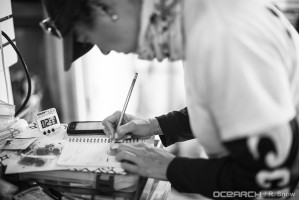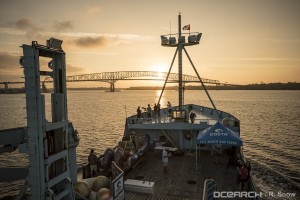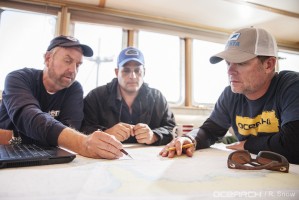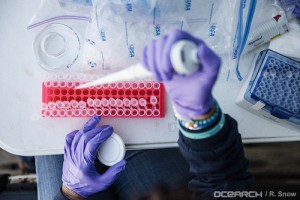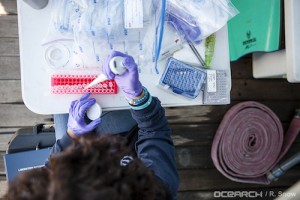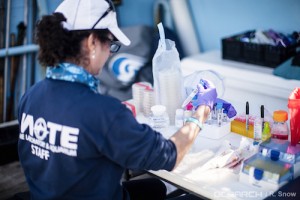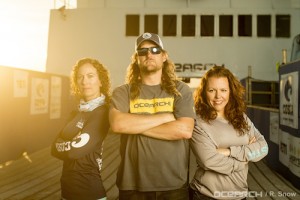Mote shark scientist shares Expedition Jacksonville updates
This past week, a team of scientists on a major shark-research expedition aboard the internationally known M/V OCEARCH tagged a second tiger shark during Expedition Jacksonville, says a participating Mote Marine Laboratory scientist who is collecting and studying shark blood samples in this team effort to learn more about large sharks in the Atlantic Ocean.
“This shark, named Viper, was a very important tiger shark because he is the third male tiger shark SPOT tagged in Brian Frazier's study of tiger sharks in the northwest Atlantic Ocean,” said Dr. Heather Marshall, Mote Postdoctoral Research Fellow, referring to the work of Frazier from the South Carolina Department of Natural Resources. “To expand on this sample size is a significant opportunity leading toward a better understanding of the sex-specific movements of this species.”
This multi-partner expedition led by OCEARCH began with an educational outreach day March 15 and officially departed from Jacksonville, Fla., on March 16. Overall, the expedition goal is to build upon previous findings and tag, sample and release more great white sharks; [while no great white sharks have been tagged so far, the team is learning from their encounters with other shark species of interest]. Participants hope to better understand the ecology, natural history, and behavior of these sharks in the Atlantic Ocean; and what physiology and health traits the sharks show, especially related to stress, body condition at release and capacity to reproduce.
So far, participants have caught six sharks: a pregnant blacknose shark, a pregnant sand tiger shark, two juvenile male tiger sharks, a non-pregnant female blacknose shark and a tiger shark.
Participants deployed a scientific tag on one tiger shark on March 25. This SPOT tag tracks the shark’s location and sends data back to scientists when the shark’s dorsal fin breaks the water’s surface.
This shark was named Viper in honor of the Space Coast Junior / Senior High School students in Cocoa, Fla. who drove two hours to visit the ship in Jacksonville.
- Look for Viper, the 7.6-foot tiger shark, on OCEARCH’s global shark tracker at www.ocearch.org
- Georgia the tiger shark (tagged March 18) can also be tracked
Mote Postdoctoral Research Fellow Dr. Heather Marshall collected blood samples from all the sharks caught to study their physiology during the stress of capture and release. While it is often assumed that many sharks survive release, it is critical to understand how often they really do, and how survival rates vary with different circumstances and species. Such data are vital for management of sharks vulnerable to being overfished and/or becoming accidental bycatch.
Blood samples can also shed light on a key step in sharks' life cycle: reproduction.
"It was very exciting to have two pregnant female sharks, confirmed by ultrasound, in the same day,” said Marshall. “A confirmed pregnancy, combined with the reproductive hormone analysis that will be performed from the blood samples I took, will help develop a better understanding of the reproductive physiology of these two species. I have never seen such an obviously pregnant shark as the sand tiger shark. It was a very cool opportunity!"
Dr. Kim Ritchie, Mote Senior Scientist, took bacterial samples from all the sharks caught to study the antibiotic-producing bacteria associated with these sharks, which can help explain the animal’s natural resistance to disease and injury. Bacteria will be cultured, purified and screened against eight human and three marine pathogens for possible new sources of antibiotics that could fight antibiotic-resistant bacteria.
“These samples are vital in advancing Mote’s goal of understanding the rapid wound healing capability that sharks, skates and rays posses,” Ritchie said. “These animals harbor bacteria that produce antibiotics and we want to know why and how the activity of these beneficial microbes may be translated to advance human healthcare.”
Read Marshall’s daily log below for a first-hand account of her research adventures aboard the M/V OCEARCH during March 15-21.
Mote scientist Dr. Heather Marshall’s daily log of shark research aboard M/V OCEARCH, March 2016
Tuesday, March 22
I woke up around 6:20 a.m., had coffee with the science team and got to work chumming in hopes of catching a shark.
Late morning, the wind totally died, and the surface of the ocean was very slick. I got a real shark-y feeling, and basically planted myself on the roof of M/V OCEARCH all day, with binoculars, various sodas and lots of chocolate to keep me focused. Lots of birds and tons of dolphins surrounded us. All day, I was fooled by dolphin fins, and once really badly by a dolphin fluke out of the water and turned on its side, so it looked like a large caudal fin. I thought that was our shark for sure. I came downstairs finally as the afternoon wore on, and chatted with Jack Morris from Mote, who came aboard for the day. Then the crew got ready to head north again off Cumberland.
We had a live Facebook chat at 7 p.m., which we would be in transit for. The science team got off with the day visitors and drove north to Fernandina Beach, where we did the live chat. We took the Contender out to the mothership (M/V OCEARCH), right as wind was picking up, so the Safeboat picked us up from the Contender, and we boarded the mothership. We arrived just in time for dinner and ate the delicious red drum dinner Luis made.
Wednesday, March 23
We got word that there was a dead whale with white sharks feeding on it in South Carolina, only 90 miles away.
Fernanda was up with production in a plane for spotting and filming, and went north to try and find the whale. At the same time, I got Jimmy’s new student, Chelsea, up to speed on the science protocol, and we prepped for our Mote SeaTrek Google Hangout, which we did with Chris Fischer and two classrooms in distant U.S. states.
That went well, and after we got done, we had lunch and then discovered that the whale was in North Carolina, not South Carolina, which was very disappointing. I had lunch (Indian food Luis made) with Caroline and Rob on the third-level balcony, starboard side, in the sun, which was gorgeous. Soon after, we learned FWC (the Florida Fish and Wildlife Conservation Commission) had spotted a white shark 15 miles offshore. It's been a shark-y day!
Our average on these trips is one shark every 8-10 days, so we are just coming up on that number of days now. I have planted myself on the roof again to watch the slick for the rest of the day. Got some music, a nice breeze and the sun. Come on sharks! I spent the rest of the day until sun was too low on the roof, and was eventually joined by Caroline and Brian.
Thursday, March 24: We caught two pregnant sharks!
I woke up at 6:30 a.m., got some coffee in the galley and then started prepping for a day on the water with Jim, who was out doing his own tag-and-release work with his students in the area.
However, I soon heard that we were actually hooked up to a sand tiger shark! Jim said this was a bucket list species for him to ultrasound and get blood, and Greg and John were excited to acoustically tag it to continue their work with sand tigers. So we reviewed our science plan and got ready. As they slowly walked the shark back to the ship, the crew told us it was female and very girthy, so we figured she might be pregnant.
We decided to keep her on her side in case she was pregnant, and we developed a contingency plan in case she gave birth to pups. Right away, it was clear that she was pregnant. It was incredible. I’ve never seen a shark that was so obviously pregnant.
We got on the cradle and got to work. I got a blood sample right away, and Dr. Kim Ritchie from Mote got to work collecting bacteria swabs and parasites. Chelsea saw the pups inside right away and got an awesome ultrasound. The tagging went smoothly all around. She was quite calm. I kept an eye on her cloaca the whole time to make sure she wasn’t starting to push her pups out. I got a second blood sample before release. The team got parasites and fin clip on ethanol (a small sample from the fin for genetic analysis), and Kim from Mote got to work processing the bacteria samples, and I processed all the blood and regrouped for our next sharks, which actually came soon after.
Our day guests were rod-and-reel fishing off the boat and caught a large blacknose shark. We decided to do a paired down work up, and Brandon laid a mat on the stern with running water, and we brought the female on board. Right away we saw she had some scoliosis in her tail, which happens sometimes in sharks. Chelsea ultrasounded her, and right away saw pups in her uterus, which was awesome!
I got a blood sample for an initial stress assessment, and for reproductive hormone analysis in Jim’s lab. After this, I processed the blood, and Kim from Mote processed her new bacterial swipes from the blacknose as well.
After this, I worked to re-prep all our gear, and make sure we were ready for our next shark. I helped with chumming on the stern for the rest of the day. That evening, I got a text from Greg Skomal’s assistant John Chisholm, who mapped out the three white sharks sighted during our trip in relation to our boat. He was very encouraging. I shared this info with the crew, and then we ate dinner.
Friday, March 25: Tiger shark named Viper is tagged!
It’s a bit rockier today, but not bad and still sunny and not too chilly. I grabbed my computer to input our data sheets from our three sharks so far.
Soon afterward, I noticed that everyone was looking at our one set of drumlines, and some movement had been spotted. The Safeboat with Chris Fischer, Brandon and Brian went to investigate, while we watched from the mothership (M/V OCEARCH). You could see an elongated upper lobe of a shark's caudal fin, so I thought it would be a tiger shark. It was!
It was a smaller, immature male tiger shark. We decided to work it up on the cradle, but didn’t want to interrupt the Contender’s white shark fishing, so Chris Fischer and his team brought the tiger shark to the lift with the Safeboat. Brian helped to lead the shark onto the cradle, and Brandon waited 'til he was lifted out of the water and then got on and got him secured and with hoses.
Brian went on tailrope, and Brandon/Chris handled the head area. I got a blood sample, and we took bacteria samples, a fin clip and body measurements. I jumped on tailrope so that Brian could get a nice muscle plug and Brandon and Chris SPOT-tagged the shark, and then Brandon took the tailrope so I could get the final blood sample. This male was named Viper, and he took off strong from the cradle. I had a lot of blood processing to do, and I stored my samples on liquid nitrogen.
When I was about done, it was lunchtime. I had a burger and chatted with Kim. The afternoon brought chilly temps and some rain. We worked until sunset, and the Contender came back. There were crazy thunderstorms this night, with thunder waking everyone up.
Saturday, March 26: We caught another blacknose shark!
I woke up at the usual time, and was full of hope because it was Rob’s birthday! Historically we have had good shark days on people’s birthdays (e.g., on my 30th we got Betsy, and on Fernanda’s we tagged three sharks). After some coffee, Rob and I hung out on the stern chumming. The morning disappeared somehow, and eventually it was pasta lunch time and then time for Bob and Kim from Mote, and Jorge to leave.
It was sad to see them go, but I needed to pull together a new science plan since new scientists wouldn’t be coming until the end of the day. So, I got that squared away and got organized for a shark while having a light science team on board. I went to the stern and saw Brandon and Chris on the Safeboat going to help rescue a gannet (seabird) that looked distressed. Brandon grabbed the bird from the water, and saw it was totally wrapped in monofilament fishing line, through its mouth and wings, so that it most likely hasn’t been able to eat or sleep for quite sometime. I got a towel for its head, and Brandon held the bird while Chris and I cut and removed the line. Once it was clean, we put it on the bow to calm down and regroup. It ended up sitting and sleeping on our bow all day!
After awhile, we saw that Brandon had a shark on the stern! We ended up doing an ultrasound and sampled another blacknose for Jimmy's lab. Samantha, Jimmy’s student, did the ultrasound, and the female was not pregnant. Just as we wrapped up and I was processing blood samples, scientists Gavin and Matt arrived! So I finished processing and got caught up with them a bit. Then the Contender came back before dinner, which was chicken and a nice salad for Rob’s birthday followed by birthday cake.
Sunday, March 27
Easter Sunday! I woke up to a pretty grey sky, which became increasingly foggy throughout the morning. I spent the morning with the science team getting our new science plan in place with scientists Matt, Gavin and Lisa Hoopes from Georgia Aquarium on board. Matt has brought two new tags to deploy on white sharks, so we made sure we were all sorted and ready for any shark. Fog rolled in very thick right before lunch, but moved out afterward and then made way for thunderstorms. We chummed through the afternoon, watching the slick and dodging the rain when it got heavy.
Monday, March 28
I woke up at 6:15 a.m., had some coffee and prepped for the day. Gavin and I discussed samples that we have sent to him previously from our other white sharks, and samples he still needs, which we’ll follow up on after the trip. Jimmy G’s students Sam and Clark swapped out, so, after a science brief with our day visitors, Clark, Lisa and I reviewed the science plan.
We heard about a dead whale being fed on by white sharks off the coast of New Jersey, and we quickly worked to determine if we should head north depending on weather, and people’s schedules. It would be amazing to set up next to a whale and tag white sharks as they come by. Brett, Fisch and Mark checked out the New Jersey coast and weather. So we are not sure where we will be headed to at the end of the day, but we are ready to do what is needed to get some white shark tags out!
